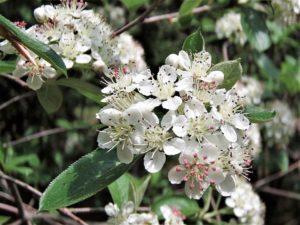Beyond the Field – Enter
By Nicola McGoff, Jefferson Chapter You drive by it every day, without notice. It is just a field. An ordinary everyday field. Square shaped or almost anyway, with very defined boundaries. Manmade boundaries stretching back through time. The sedentary, fallow field. Static and uninviting for most. A place where utility trumps esthetic. Perchance, one day…
Read MorePhasing Out the Sale and Use of Invasive Plants
Updated January 19, 2022: View the Working Group Final Report at the Virginia Legislative Information System. Virginia House Joint Resolution 527, approved unanimously in 2021, calls for a study that will explore options for phasing out the sale and use of invasive plants in Virginia’s horticultural industry, and to promote the sale and use of…
Read MoreSkunk Cabbage Secrets
By Nancy Sorrells On this winter weather Valentine’s Day I decided to journey back into the forest behind our property to the secret place I know where the globally rare Swamp Pink (Helonias bullata) grows. Today’s visit was not to see Swamp Pink, which is still sleeping and will not send up its amazing pink…
Read MoreWildflower of the Year 2021 American Wisteria (Wisteria frutescens)
Wisteria frutescens is a woody liana, potentially growing to heights of 15 m; young stems are smooth or covered with small hairs pressed tightly to the stem surface. Stems climb by twining around supports in a clockwise direction. Leaves are alternate and odd-pinnately compound, 10—30 cm long. Leaves may have from 5 to 15 leaflets…
Read MoreA Parasitic Lifestyle: Beechdrops and Their Relatives
By Marion Lobstein Two primary characteristics of plants are a light-capturing pigment, chlorophyll, which gives most plants a green color, and the use of this pigment to capture light energy to carry out photosynthesis to produce energy-rich food from carbon dioxide and water. This kind of plant lifestyle is known as autotrophic or self-nourishing. Indian…
Read MoreRed Chokeberry Shines in All Seasons
By Betsy Washington, Northern Neck Chapter Red Chokeberry (Aronia arbutifolia) is a versatile landscape shrub that shines in all four seasons of the year. In spring, showy clusters of up to 25 pristine white, or pink-blushed flowers light up the garden. Throughout summer the foliage is a lustrous dark green, then ignites in fall with shades…
Read MoreGoldenrod Glows in the Fall
By Richard Stromberg Along with Asters, Goldenrods are the dominant flowers in September. Some of them continue flowering into October, and you will see their fluffy seed heads all winter. Goldenrods have small-flowered, yellow spikes and sprays. Twenty goldenrod species are frequent in the Piedmont Chapter area. Note that the large leaves at the base…
Read MoreThe Pipevine Swallowtail Butterfly and its Native Host Plants
By Mary Lee Epps, Jefferson Chapter I decided to write this article for our chapter Newsletter, The Declaration, because of an experience I had two years ago. On a family outing to the Dripping Rock area of the Blue Ridge Parkway, we explored a trail that leads from the west side of the Parkway. After…
Read MoreAll About the Stamens
By Betty Truax, Jefferson Chapter Years ago, when I lived in Northern Virginia, my mom gave me a Mock Orange plant that had no scent. It was a shared plant from her friend Anna Davis in Rochelle, Virginia. The plant was important to my mom because it reminded her of being young. With this particular…
Read MorePurple Passionflower Pops in Summer
By Betsy Washington, Northern Neck Chapter Driving along sandy roadsides and fields of the coastal plain in summer, it is always a delight to find our native Purple Passionflower (Passiflora incarnata), a deciduous vine with dark green, three-lobed leaves and exquisite, showy flowers and edible fruit. This vigorous vine is native to the southeastern United…
Read More









